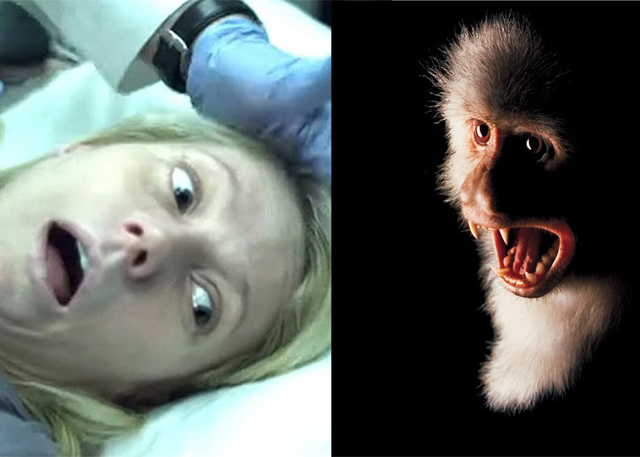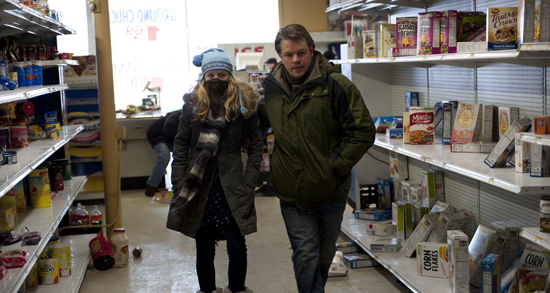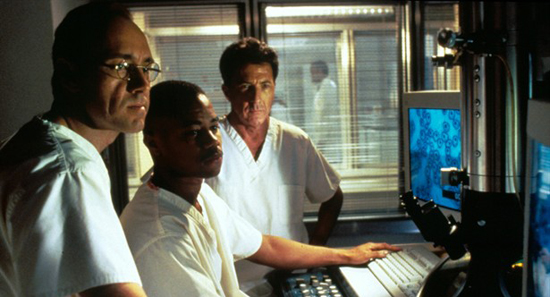
The 2020 pandemic almost at times feels like we are living through a movie in real time. Acts of heroism and selflessness within our hospital walls; families suddenly stricken with the hardship of loosing their financial security; dysfunction at the highest levels of our governing bodies. If it all weren’t so tragically real, this day and age would make for a harrowing thriller. And I have no doubt that once Hollywood does eventually land on it’s feet after this is all over, we will see multiple dramatic recreations of this period of time. In many ways, real life has eclipsed fiction with it’s unpredictability. But, in the past, we have seen Hollywood take a shot at dramatizing the possible effects of what a worldwide pandemic may be like. The only problem is audiences up until now had no interest in movies centered around medical crises. Most global pandemics don’t quite have the grisly sort of fatality that’ll intrigue audiences, as many of them are slow, possibly less lethal diseases. So, for many pandemic movies, the filmmakers usually spice things up by adding something else to the mix, like a plague of zombies. This is evident in things like Danny Boyle’s 28 Days Later (2002) or Will Smith’s I am Legend (2007). Usually it’s a story about science run amok or about the fragility of human civilization, but as we can see, the disease alone has not been the thing that has interested filmmakers about pandemics, but rather the fallout that comes after. What is rare in Hollywood is a movie that actually takes a good serious look at the actual steps taken towards combating an out of control viral outbreak. Given how COVID-19 has taken over pretty much every part of our lives this year, it’s interesting to look at some of the few movies that actually have dramatized what a response to a pandemic would look like, and in some cases it’s interesting to see just how close and how far some of them actually came to showing what would actually happen.
The last time a global pandemic raged through the human population with such a ferocity as COVID-19 has, cinema was still in it’s infancy. Whatever little documentation we have of the 1918 Spanish Flu pandemic has been the historical basis on which we have drawn from for most of our understanding of viral outbreaks. COVID-19, like the 1918 Flu, is a respiratory disease with a very high transmission rate, but up to now has been thankfully less lethal; helped greatly by the lessons we learned from the last outbreak and the advances in medicine we’ve made since then. But because Hollywood didn’t yet exist during the 1918 pandemic, there is little to no film documentation that chronicled the horrors of that plague. So, Hollywood has had to rely heavily on past tense information or just use their imagination. Now, there are two different ways that a Hollywood movie can dramatize a pandemic on screen; either remain very true to the scientific realities of a pandemic, or just make a whole lot of it up to punch up the drama. Two of the most noteworthy pandemic movies represent both of these examples. One is the movie Outbreak (1995) from director Wolfgang Petersen, and the other is Contagion (2011) from director Steven Soderbergh. The former takes the pandemic concept far less seriously and uses it as a backdrop for your typical Hollywood action movie set pieces. The latter delivers a deadly (no pun intended) serious dramatization of each step of a global pandemic. Each has it’s set goals, and having watched both of them in the middle of an actual pandemic does offer some interesting insight into the different ways to tackle the same subject from differing angles. The question isn’t does one more accurately depict a pandemic better than the other, because there is no question that the more scientifically sound Contagion comes out on top. What is more intriguing when analyzing both movies is whether or not they do their job well in actually turning a pandemic story into a compelling piece of cinema on their own.

“Why can’t they invent a shot that keeps time from passing?”
First of all, you’ve got to look at the time periods in which the movies were made in order to see how they viewed what a threat of a pandemic would actually look like. The movie Outbreak came out in the middle of the 1990’s, which was both a time of relative good health on the medical front globally, but also one where new emerging diseases sparked periodic anxiety. Take for instance the emergence of Ebola in sub-Saharan Africa in the mid-90’s. This devastating disease really worried a lot of people across the world, because of the high level of suffering the infected endured before succumbing to the bug. Thankfully, it was found out that Ebola outbreaks could be easily isolated because of it’s low transferable rate, or as the World Health Organization (WHO) calls it the R0 value. But still, the world took notice and wondered what would happen if the disease made it’s way over here. At the same time, the world was also dealing with the fallout of another devastating pandemic that sadly went unchecked for years; the AIDS pandemic. Because LGBTQ were scapegoated for much of the spread of the sexually transmitted HIV virus that caused AIDS, the treatment of this particular pandemic was sadly never given the right amount of containment, and it ended up ravaging it’s way through the oppressed queer community. In the mid-90’s, Hollywood was finally acknowledging the devastating reality of an unchecked pandemic like AIDS, especially after losing some of their own to the disease, and the need to take pandemics more seriously became much more paramount as a result. For the movie Outbreak, they use the examples of these notorious pandemics as the basis for their own. It starts from Sub-Saharan Africa like Ebola, and it’s transmission through human contact is similar as well. It’s origination from primates takes it’s inspiration from the HIV virus, but that’s where the comparisons end. From there, we see Hollywood’ imagination go wild, and it’s not exactly true to science from that point on.

“Go without a mask. You’ll see better.”
Contagion on the other hand almost plays out like a handbook from the Center for Disease Control (CDC). Truly, upon watching this movie in the last week or so, I was struck by just how on the nose it was with regards to showing the moment by moment happenings of a global pandemic crises. Made almost 9 years before the COVID-19 outbreak, Contagion is eerily prophetic. It’s a respiratory disease that spreads rapidly, originated in China, causes a devastating impact on the global economy, and it exposes the fractures within our disease response system. The one major difference is that COVID-19 is far less lethal than the one in the movie, which ends up killing in the millions within a two month span. As bad as COVID-19 is, it’s global death rate remains low, and some countries have managed to successfully irradiate it altogether; sadly America is not one of them. Contagion’s disease really shows us a worst case scenario and it is refreshing to see a movie where the science is focused on so intently. The movie shows a well researched analysis of how a pandemic response would play out, both when it’s running effectively and when it is not. At the time of the movie’s making, the most noteworthy pandemics we had known in the new century were the short lived ones like SARS, the Bird Flu, and the Swine Flu. The H1N1 Swine Flu in particular served as a dramatic inspiration for Contagion, because it was the one freshest in everyone’s mind. The 2009 outbreak led to the most widespread roll-out of Disease Control protocols in a long time, though it stopped short of extreme measures like social distancing and stay at home orders. Contagion examines what would happen when that next step was needed, and sadly, reality and fiction would collide in less than a decade.
One of the biggest differences between the movies is no doubt the style of film-making. Wolfgang Petersen has built a career making big, bombastic action films. From his groundbreaking war pic Das Boot (1981), to his gritty natural disaster epic The Perfect Storm (2000), to the sword and sandals extravaganza Troy (2004); he is a director that likes to make his movies big and loud. Unfortunately, pandemics don’t offer a lot of action, because it’s just doctors in PPE trying to keep people alive in hospitals. So, for Outbreak, he pushes the science to the background and instead adds a lot of melodrama to the story. The movie turns into a conspiracy thriller halfway through, with the military brass wanting to flex it’s muscles in response to the outbreak of this deadly disease. It’s a very 90’s movie, where there is a lot of posturing and virtue-signalling from the movie stars playing doctors. Dustin Hoffman’s lead character does some pretty reckless actions in order to diffuse the warmongering actions of Donald Sutherland’s General at Arms, and it makes the movie less about teaching it’s audience about the real threats of a pandemic, and more about a good guy vs. bad guy showdown. Subtle, this movie is not. Sutherland’s general even chooses to use a nuclear option to eradicate the disease; which would’ve seemed far fetched in the Clinton years, but maybe not so much during this current Trump administration. Soderbergh’s approach, by contrast is extremely stripped back. There are no explosions, no virtue-signalling, and very little melodrama. The multitasking filmmaker basically treats the movie like a docudrama, showing every moment with the utmost sincerity towards the subject. It’s refreshingly informative, but perhaps a little too dry as well. Say what you will about Petersen’s bombastic style; it’s often entertaining. Depending on what you’re looking for, something sober or something explosive, each movie offers it’s unique take on the issue of viral pandemics.

“Godzilla, King Kong, Frankenstein all in one.”
One of the most interesting things that both movies do have in common besides the infectious diseases is that they both feature all-star casts. Outbreak has the previously mentioned Hoffman and Sutherland, but all features the likes of Kevin Spacey, Rene Russo, Cuba Gooding Jr. and Morgan Freeman. Not to be outdone, Contagion has Matt Damon, Laurence Fishburne, Marion Cottilard, Kate Winslet, Jude Law, Jennifer Ehle, Elliott Gould, Bryan Cranston, and Gwyneth Paltrow as patient zero. It’s a stellar line up of Oscar caliber talent lined up on both sides, but the difference between them is in how they are used. Outbreak unfortunately saddles it’s incredible cast with a laughable, illogical script. Dustin Hoffman suffers the most, because he’s got to carry the dramatic weight of the plot on his shoulders, and it’s clear that he really is not all that into the performance. The one nice thing about watching Outbreak today is that you do see Kevin Spacey get infected with the disease and he suffers to the point of bleeding out of his eyes, Given what we know now about Spacey, this moment does have a nice cathartic undertone now. The cast of Contagion are much better served by the script to their movie. Contagion doesn’t waste time building character motivations, nor does it try to give any of them a self-aggrandizing savior moment. The movie plops all these disparate characters into the situation of a pandemic out of control, and defines them by their actions in response. The performances for the most part are muted, but that serves the purpose of the film perfectly. Damon comes off very believable as a protective father trying to keep life for his beleaguered daughter as normal as possible . Fishburne is very convincing as the overwhelmed CDC director. The only downside for the cast in the movie is that there is perhaps too many of them. The movie jumps from story-line to story-line so rapidly that few if any of the subplots ever feel fully fleshed out. Marion Cottilard’s kidnapping subplot in fact seems to have been forgotten about for almost a third of the movie. Even still, it does a good job of keeping the through-line of battling the disease the driving force, and every actor is committed to each role they play.
What I think really puts Contagion ahead is the fact that it gives us a more provocative look at society in general with regards to how we respond to something like a pandemic; something of which that has become more profound during this year. Outbreak keeps things fairly small, so that it doesn’t have to delve too much into the moral grays of society. For Outbreak, it’s a clear good vs. evil plot as the enlightened doctors face down the interference of ignorant military personnel. That’s basic Screenwriting 101, but the true science behind disease control is that viruses hold no allegiance to ideology. Everyone is at risk, and to turn the film into a clear cut battle of ideas, the disease must take a back seat. Contagion does a much better job of showing that the frailty of civilized humanity is not a by product of a pandemic, but rather it exposes the cracks that are already there. This is perfectly encapsulated in the character played by Jude Law, a renegade journalist that tries to use the pandemic crises to further his own career. He uses his platform in the movie to tout an unproven drug treatment as a cure for the disease and secretly profits off the sale of the same drug. Sound familiar. Sure, the character exists as a means of giving the story something of a antagonist, but as we observe in the movie, his success only happens because of the desperate greed that society is driven towards in self-preservation. By not educating ourselves and listening to science, we have made it easy for grifters like the one in this movie to get away with their shenanigans, and that’s a harsh indictment on all of us as a whole that this movie makes. Even the “good guy” scientists in the movie are not beyond making selfish acts, like when the CDC director recklessly instructs his wife to leave one of the hot spot cities, which inevitably leaks to the public and causes the public to start panicking. By not letting the audience off the hook, Soderbergh creates a far more resounding message in his movie, and given what has happened this year, it’s any wonder why we didn’t see this crises coming.

“We are fugitives of the law. Idiocy is our only option.”
Neither movie is perfect, but Contagion is far more interesting to watch in our current pandemic ravaged world right now. Outbreak comes from a more innocent time that viewed widespread pandemics as more fodder for science fiction. And indeed, that has been the way Hollywood has treated the threat of pandemics on the big screen; as something far-fetched. I’m honestly surprised that Contagion not only took the genre in a far more serious direction when it did, but did so with so much scientific insight that it nearly predicted the future. We know the truth far too harshly now that pandemics are all too real. It’s happening now, it’s happened before, and it will happen again. Hopefully, the lesson of 2020 will prepare us for something worse in the future, but then again, I’m sure that they thought the same thing back in 1918. Anyone looking for something light and escapist can look to Outbreak, with it’s cheesy quaintness. It’s a product of it’s time, and while not even remotely worth seeing to inform yourself about the way pandemics work, it is ridiculous enough to show just how off the mark Hollywood can get sometimes in a hilarious way. If anything, it’s far more offensive as a waste of a good cast rather than an affront to cinematic story-telling. Contagion on the other hand is very informative and eerily true to life. It’s not for anyone looking for an edge of your seat experience, but at the same time, you’ll be blown away by just how close it actually got to predicting the current predicament we are in now. For anyone needing a clear cut explanation of how Disease Control works and how to do it properly, Contagion offers the best possible example that I think has ever been put on screen. It’s provocative without being patronizing, and shows us exactly how our own actions have an effect on our ability to fight these kinds of devastating diseases. In this regard, Contagion ultimately remains a very positive film even with the horrible tragedy at it’s center, because it shows science as a rescuing force in our world, something we should be spotlighting more often. For the movie, misinformation is the real enemy of good health, and by sticking so close to the actual reality of disease science, we see a perfect visual playbook there to guide us through the right way to deal with a pandemic. If only we had followed it from the beginning.

“Somewhere in the world, the wrong pig met up with the wrong bat.”